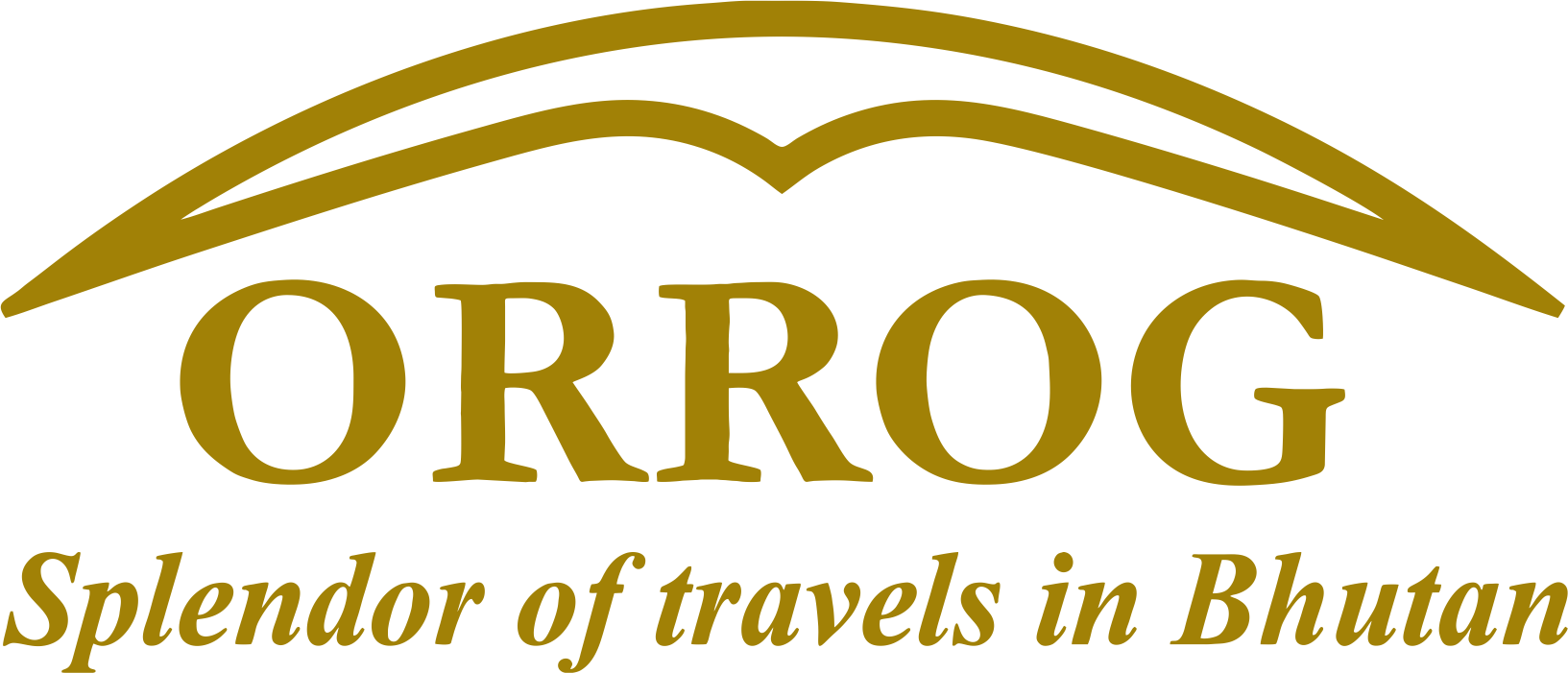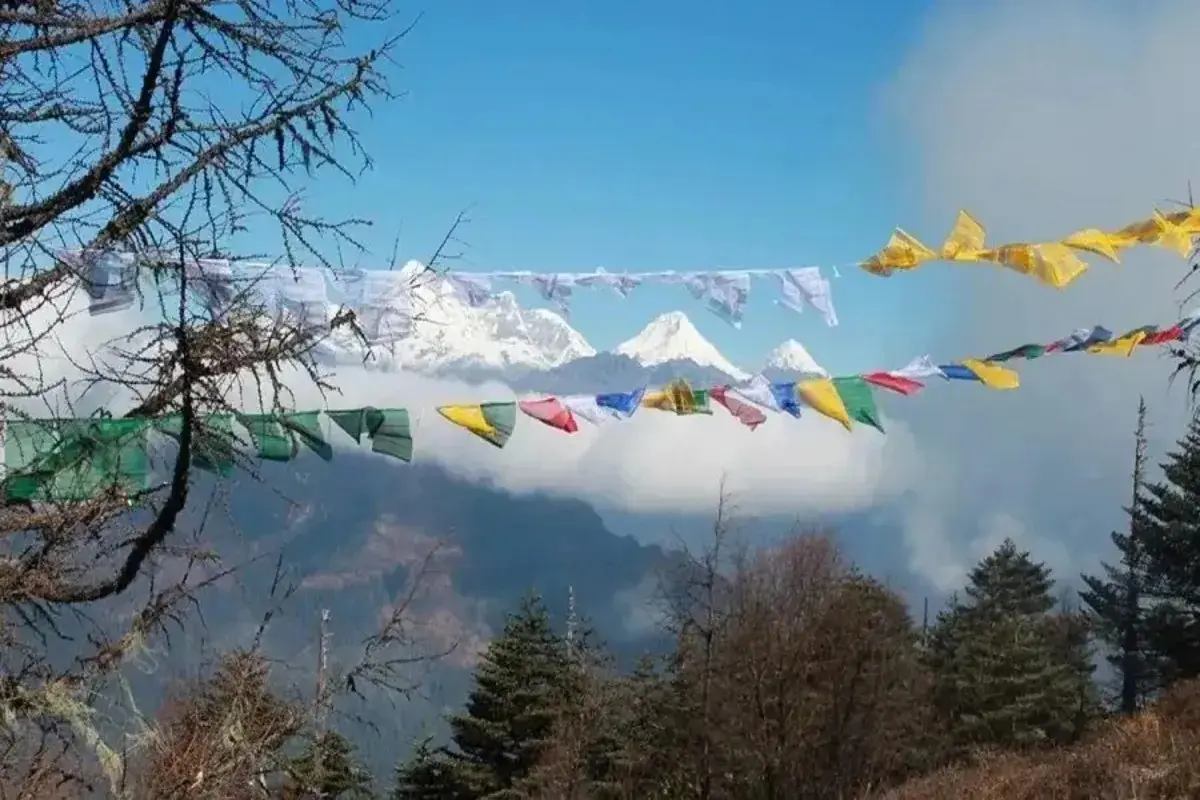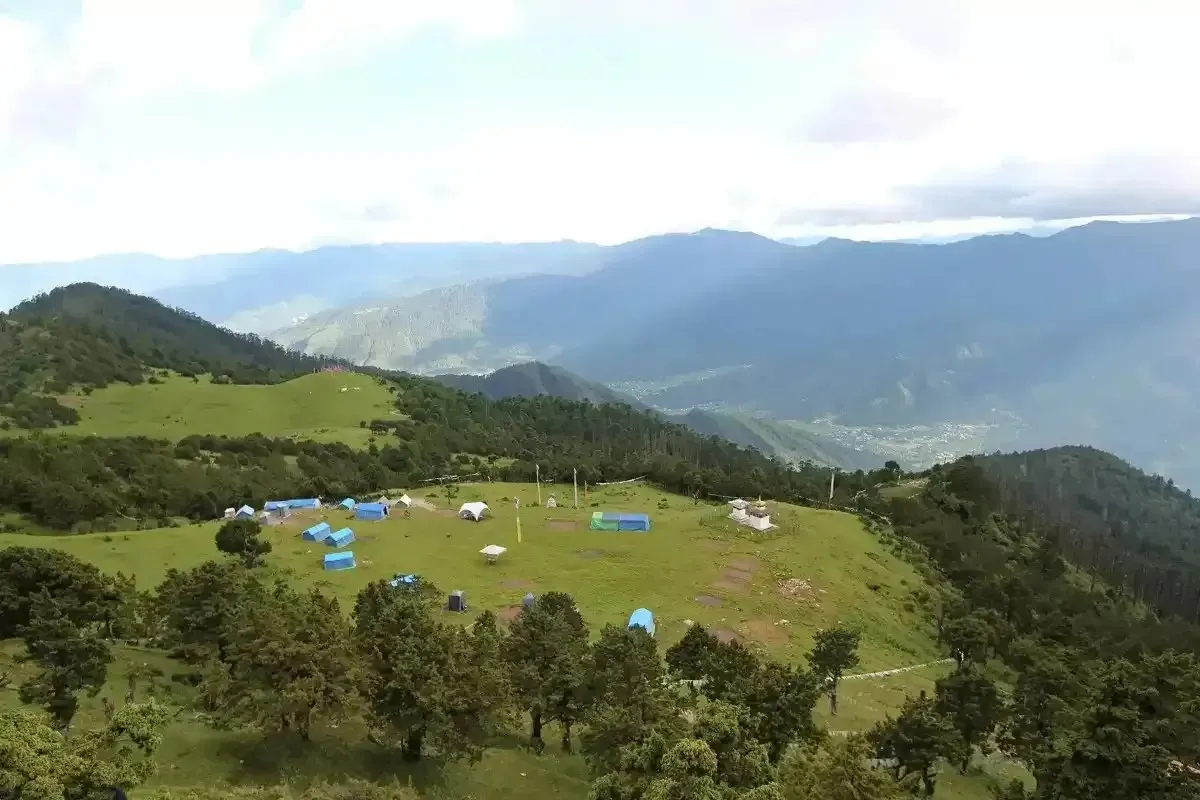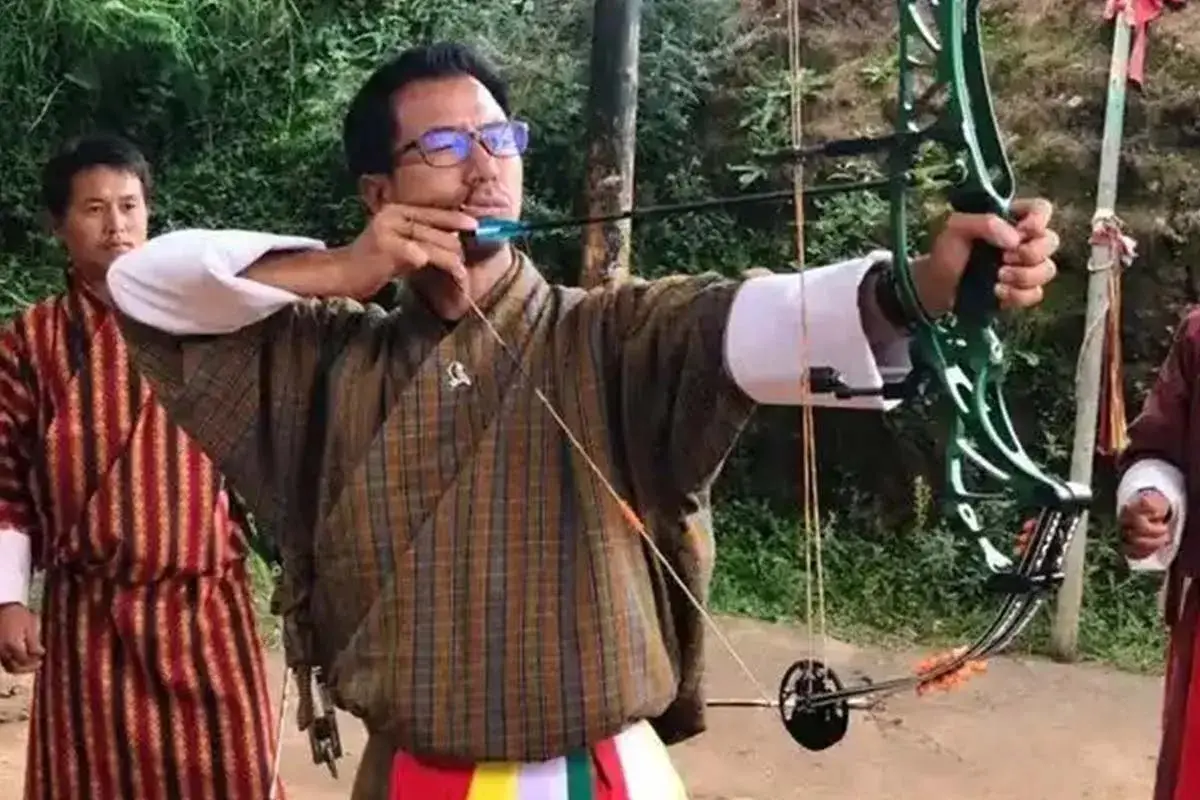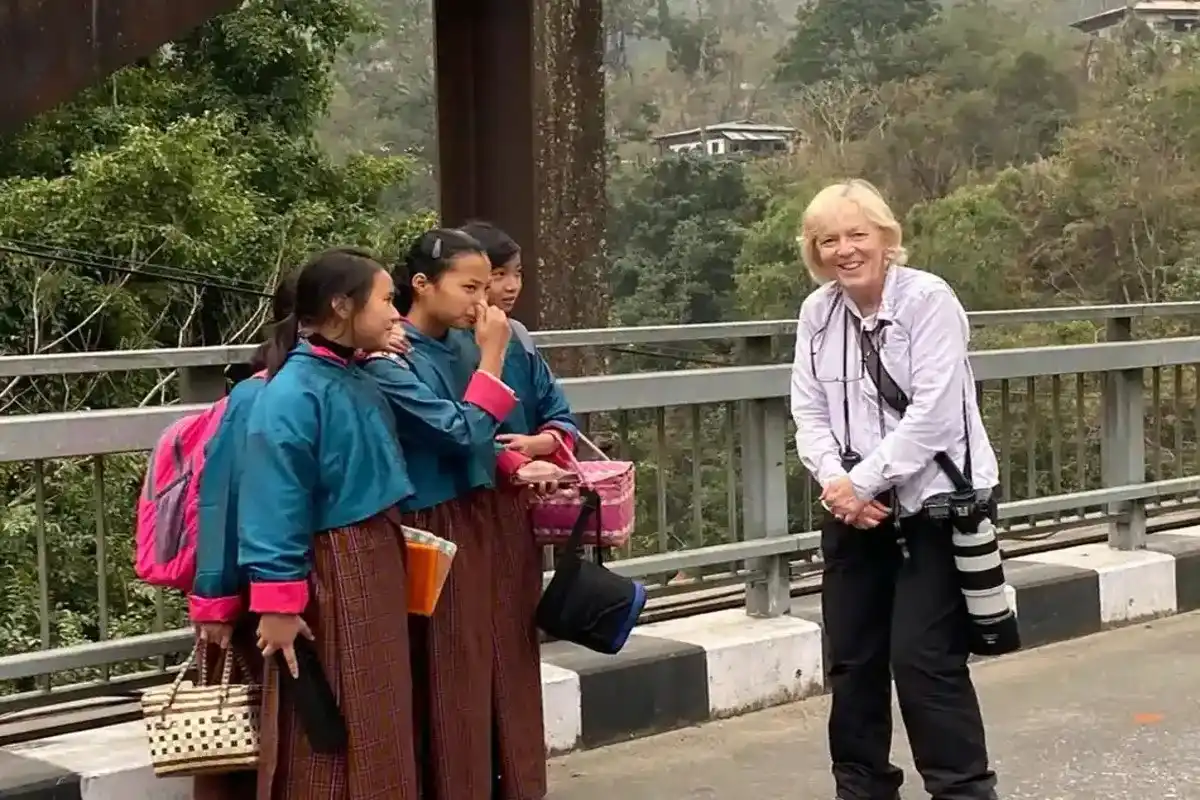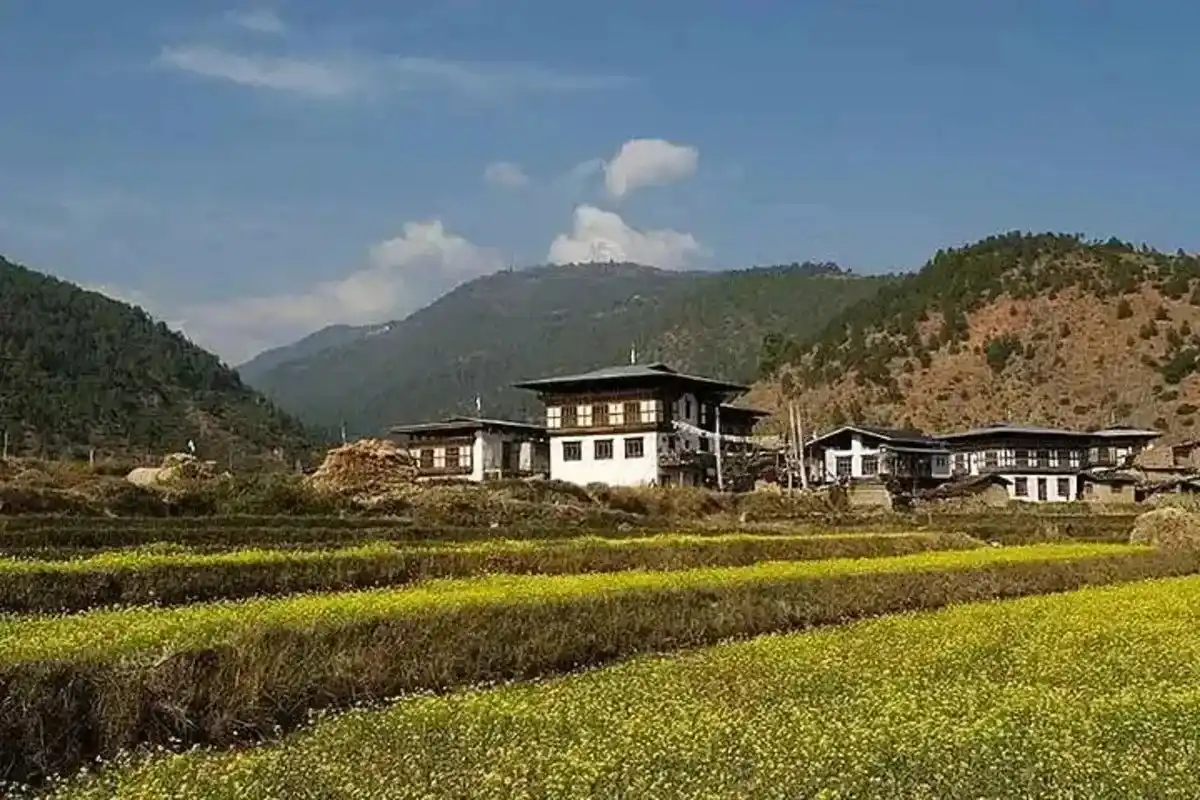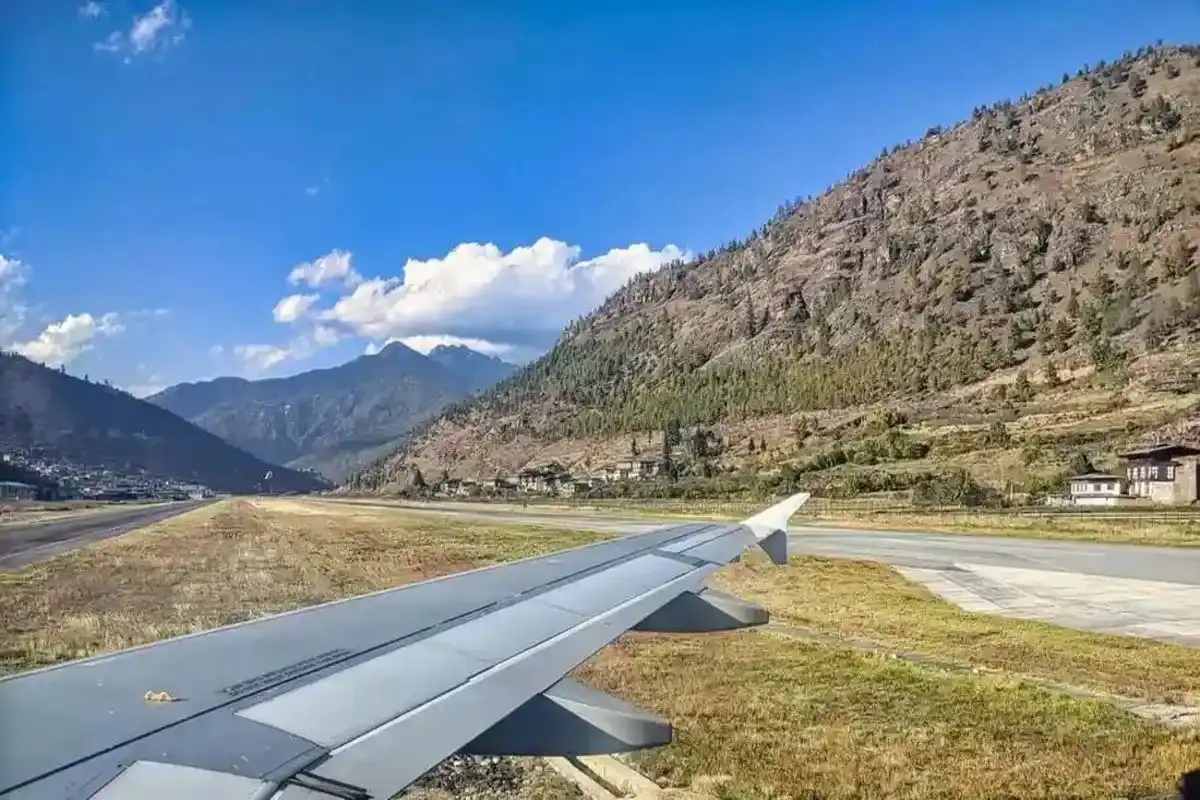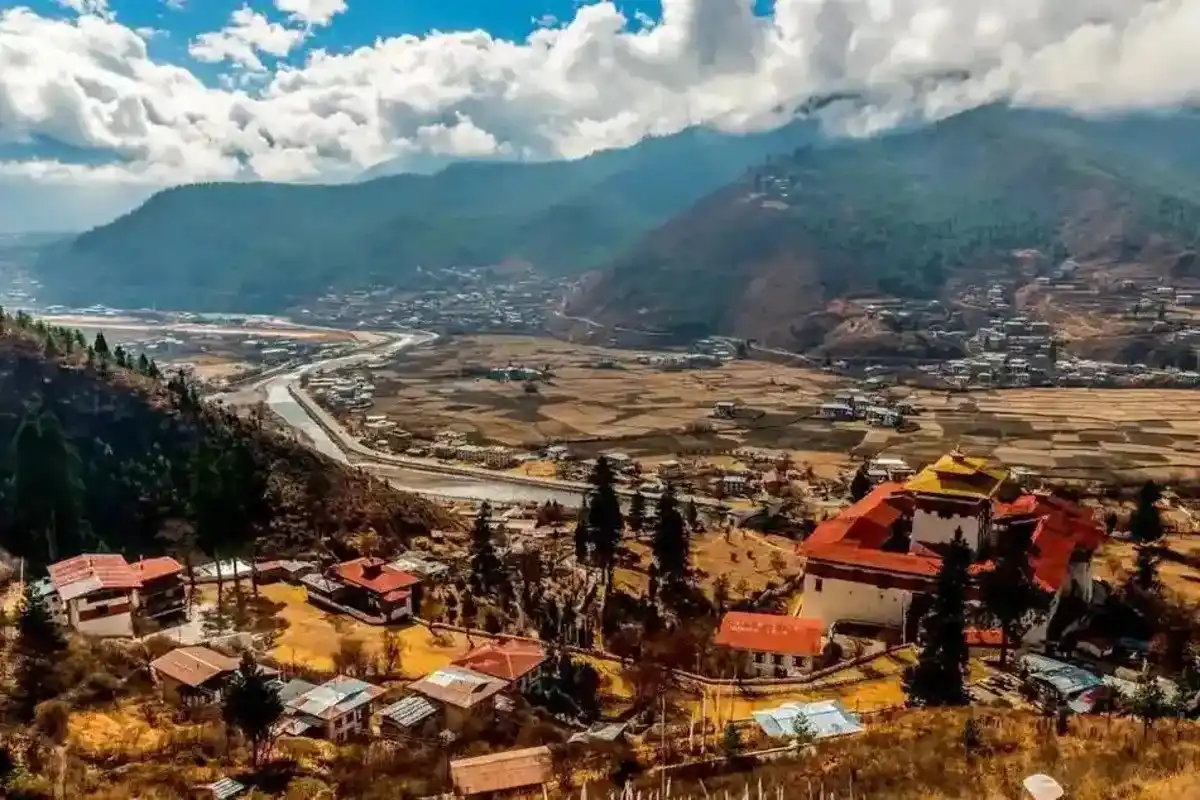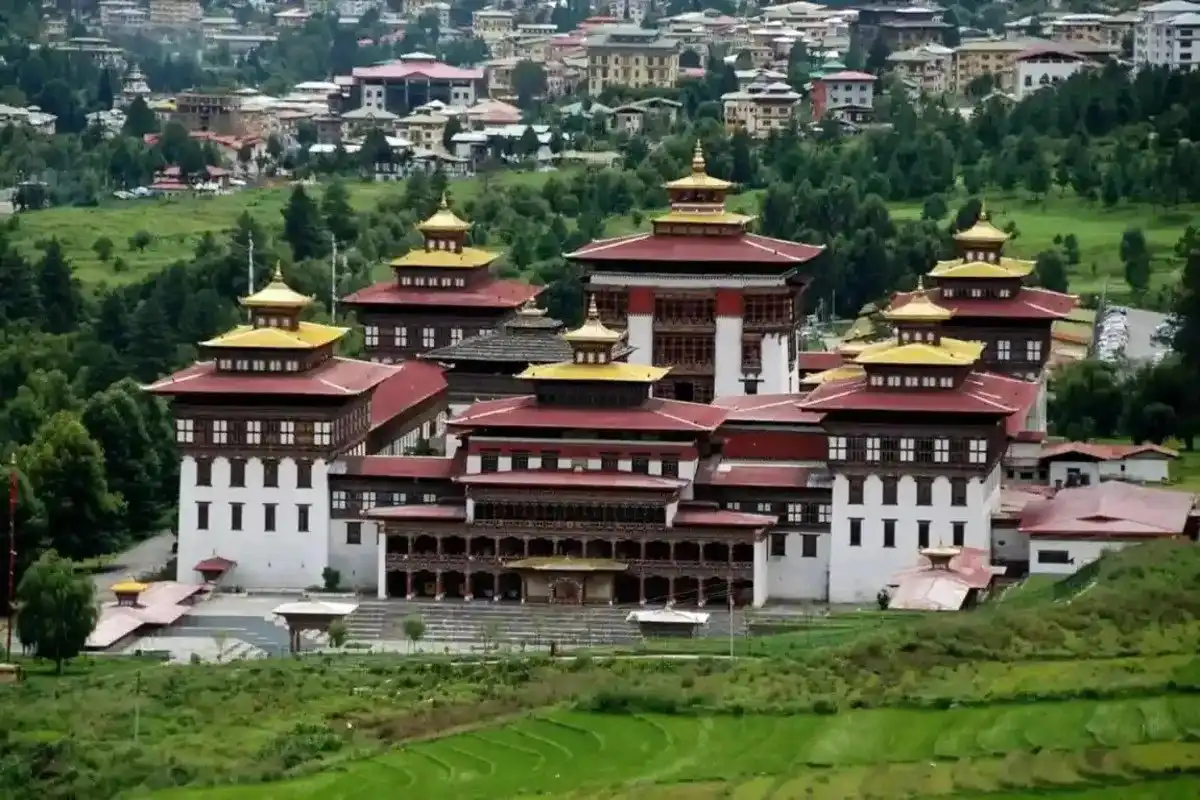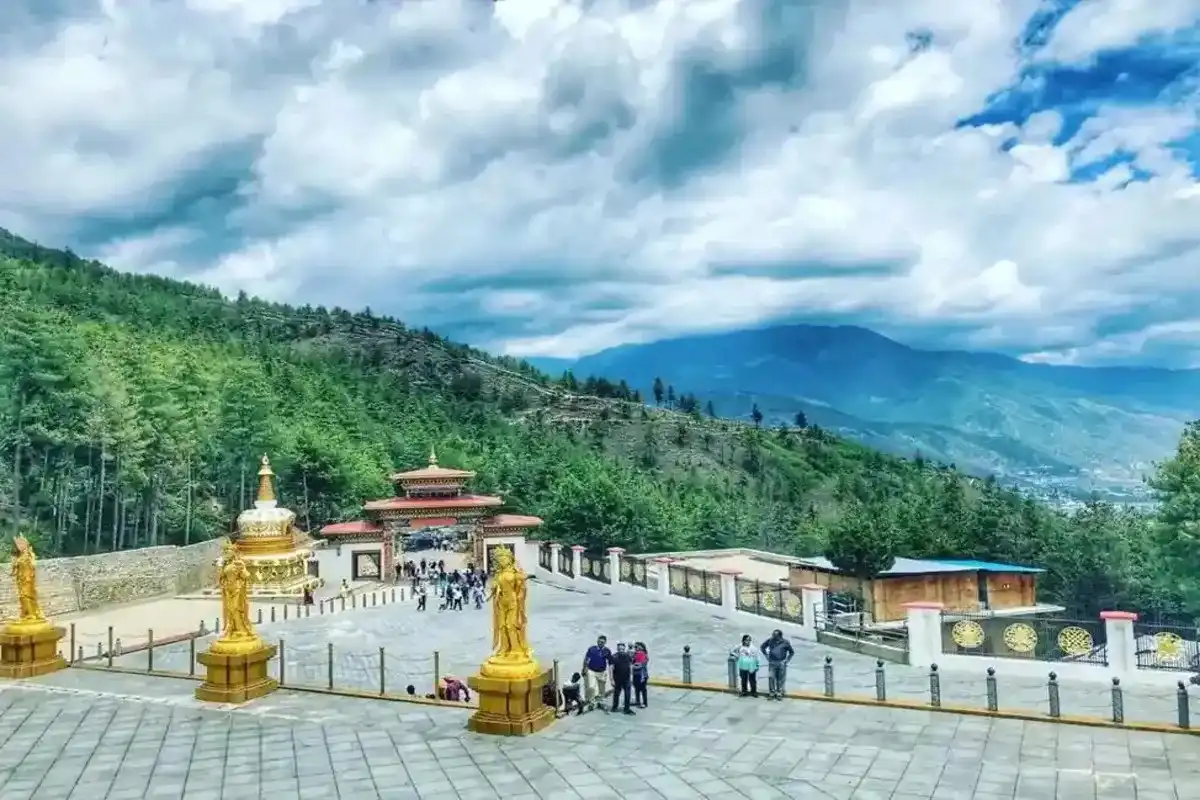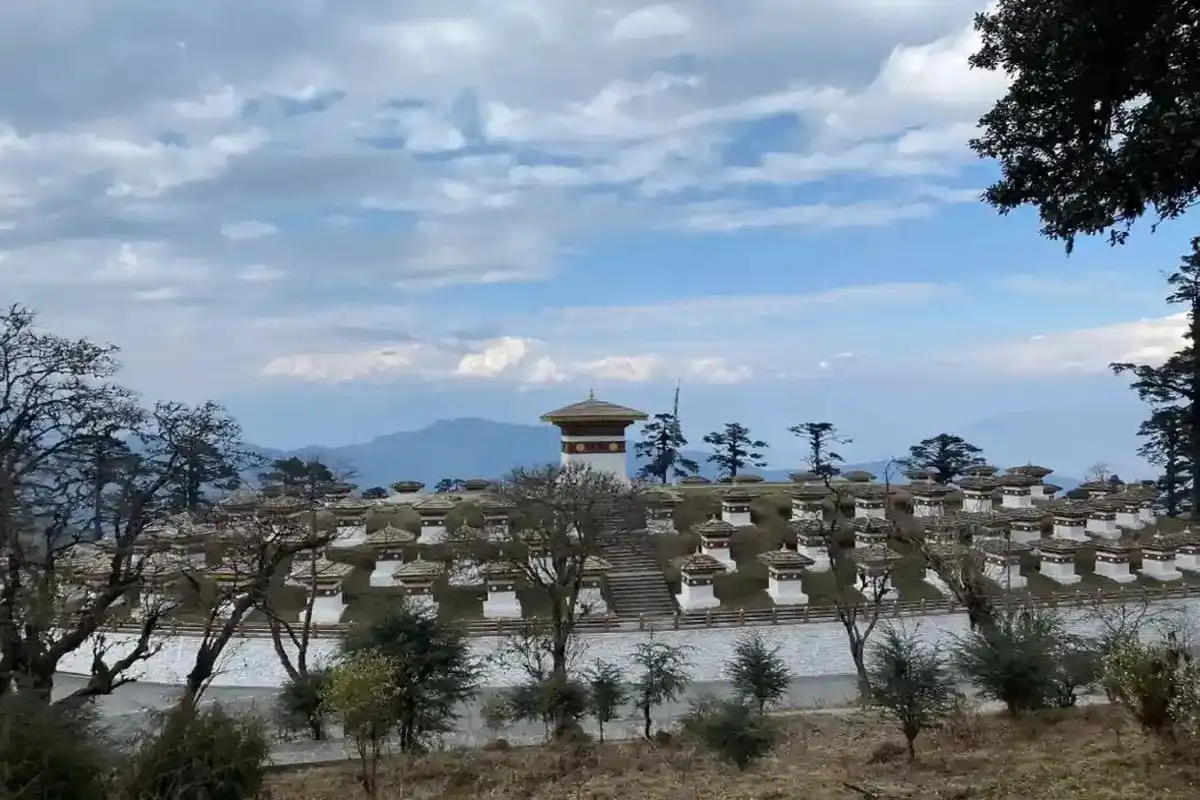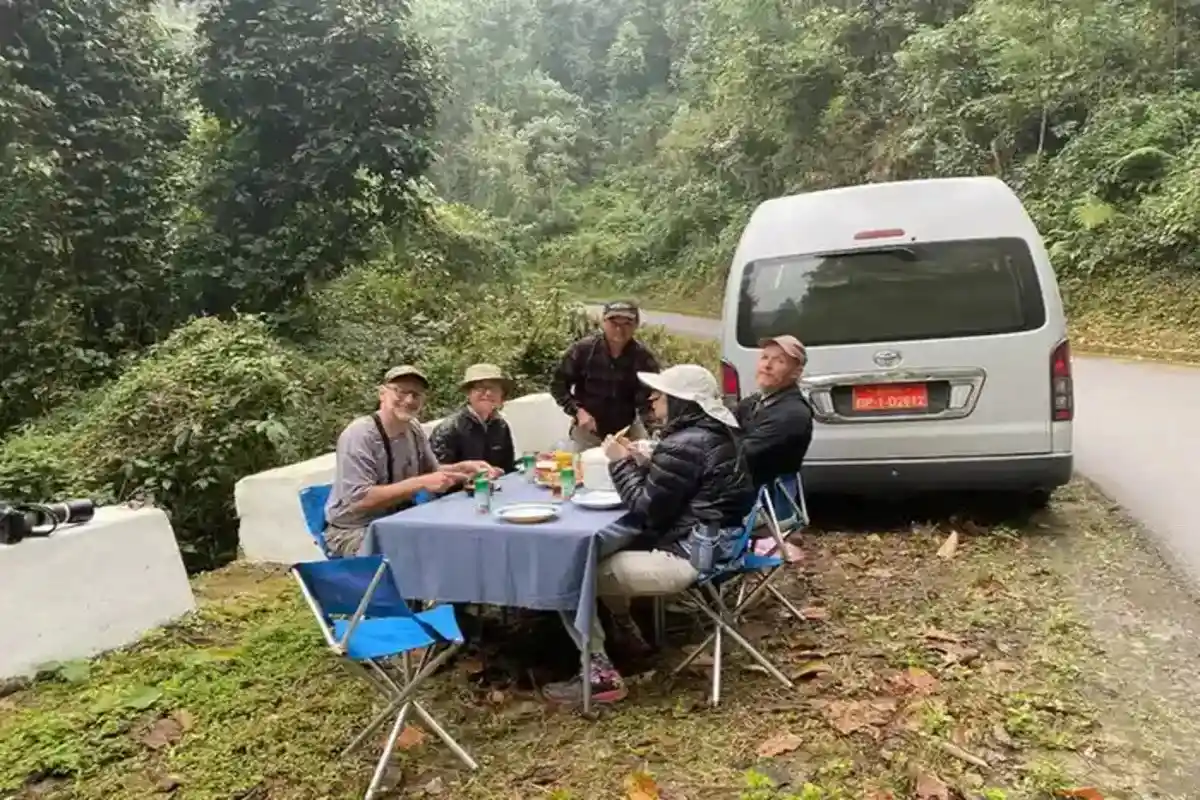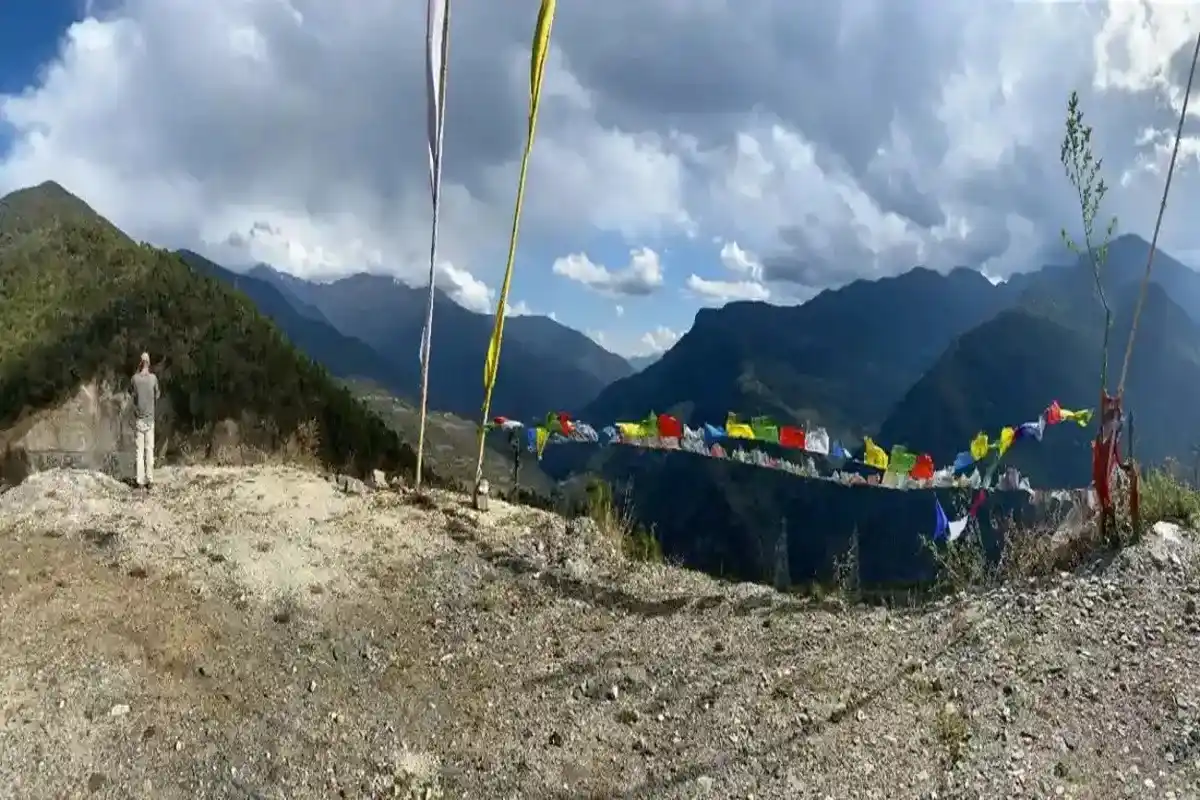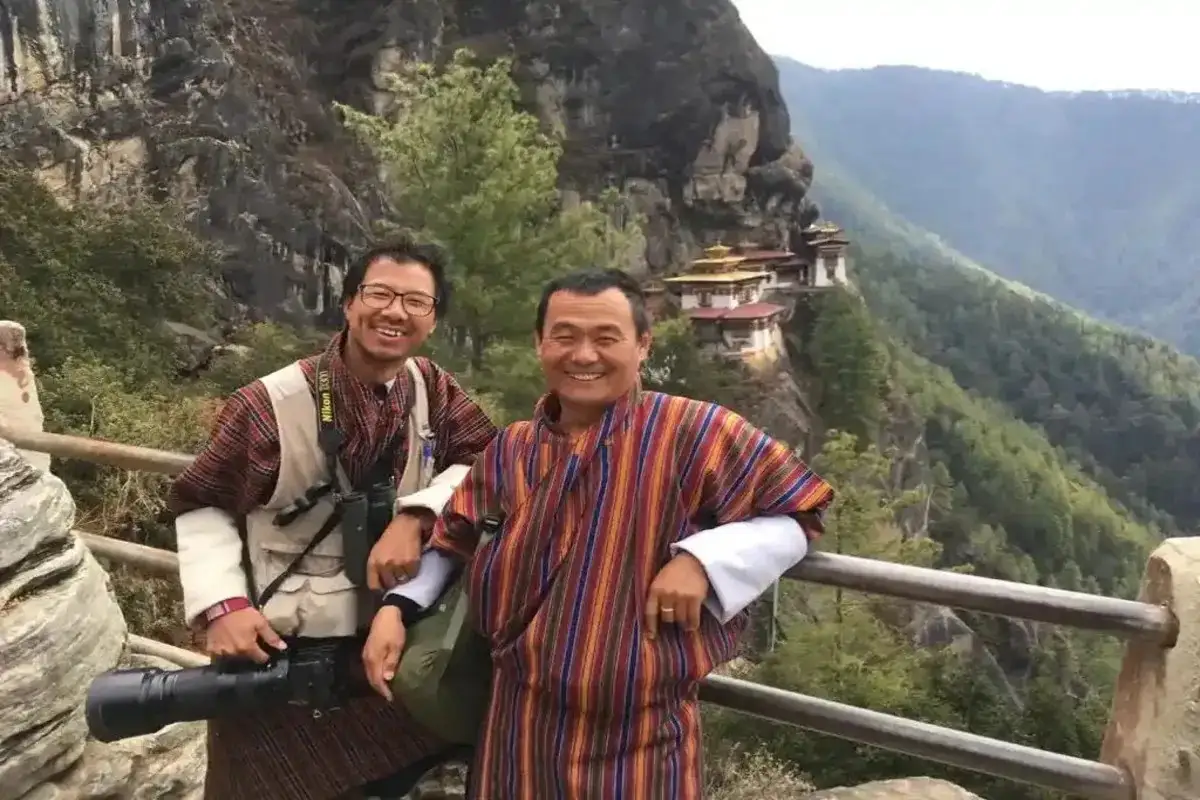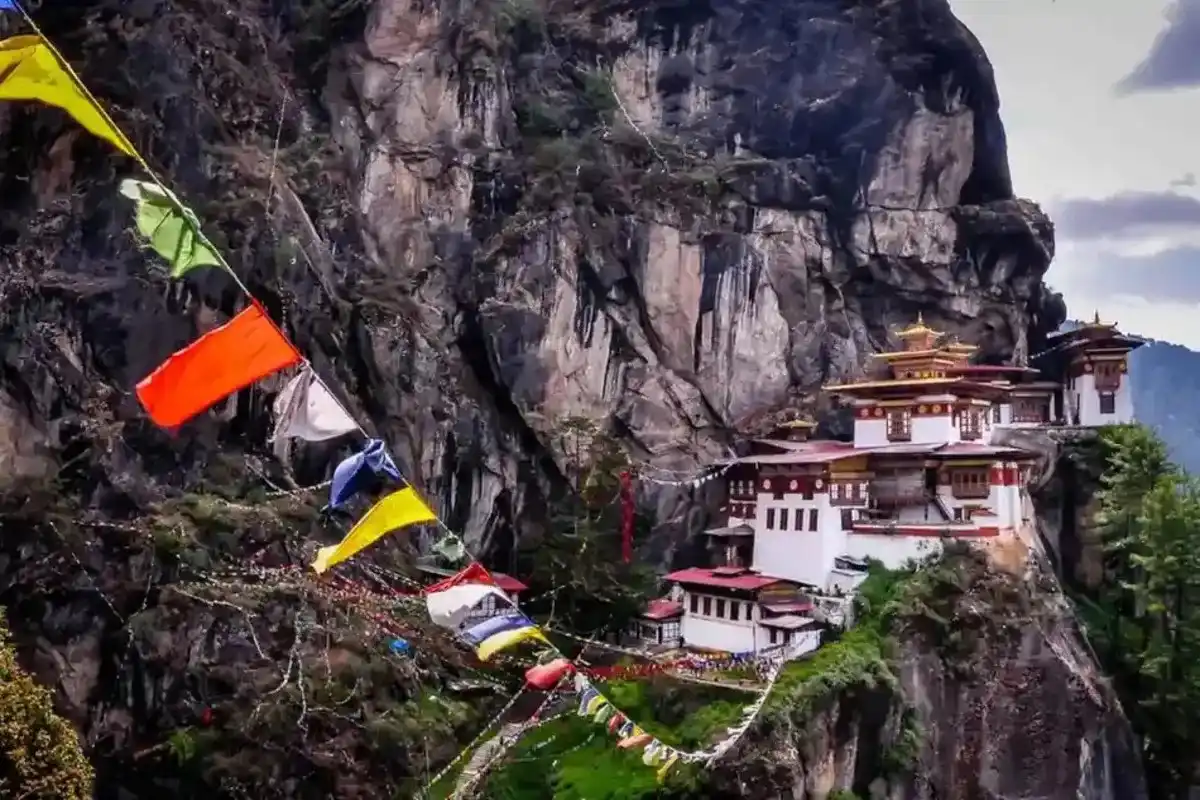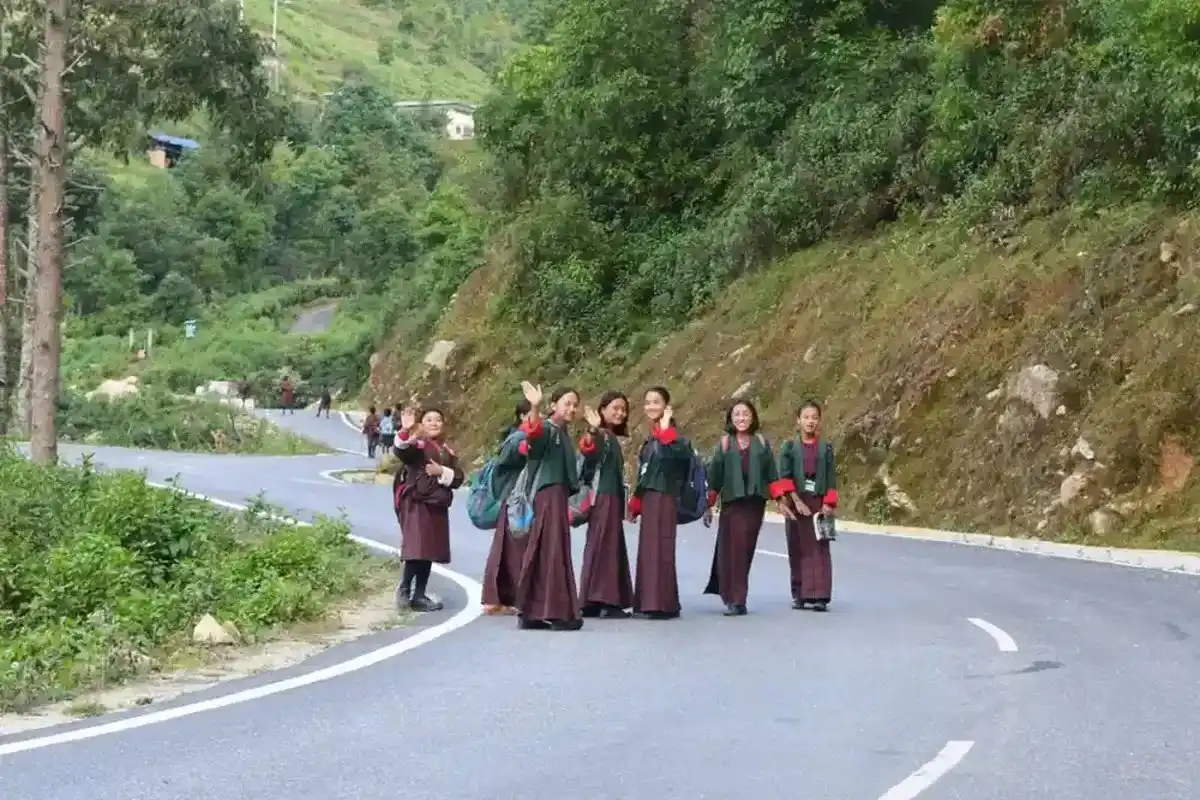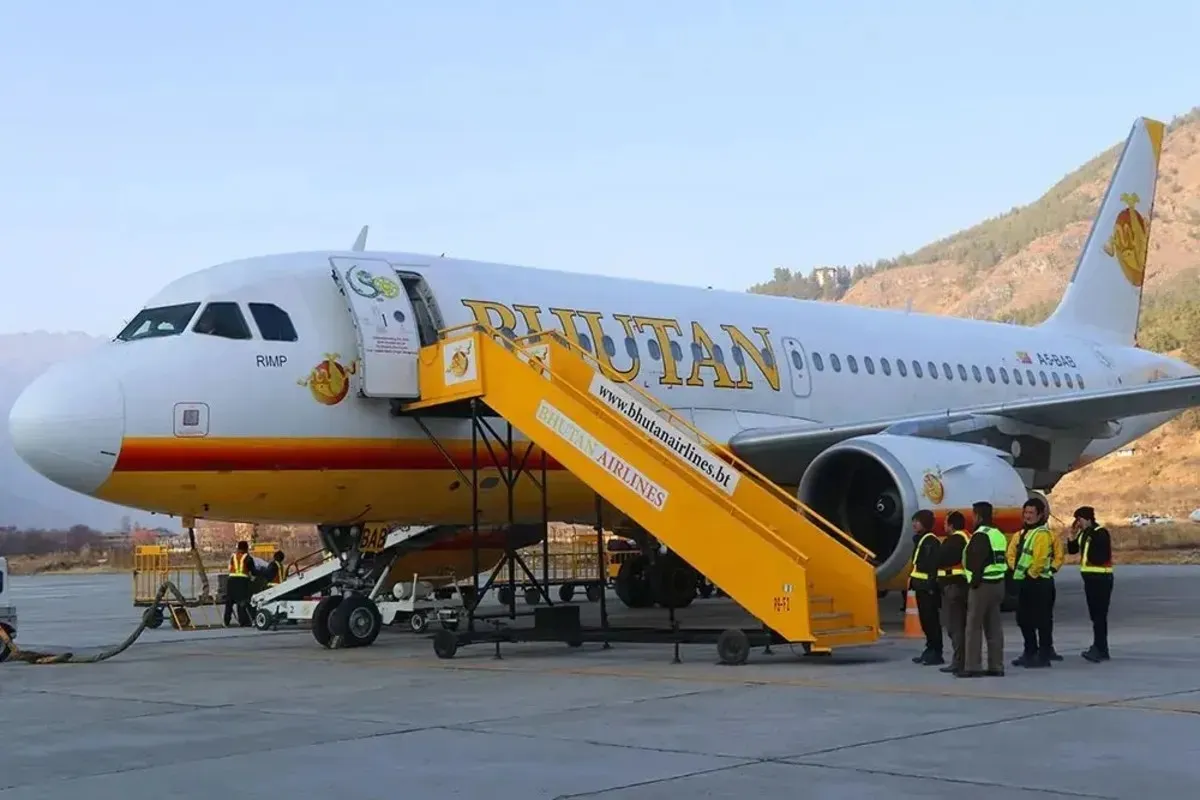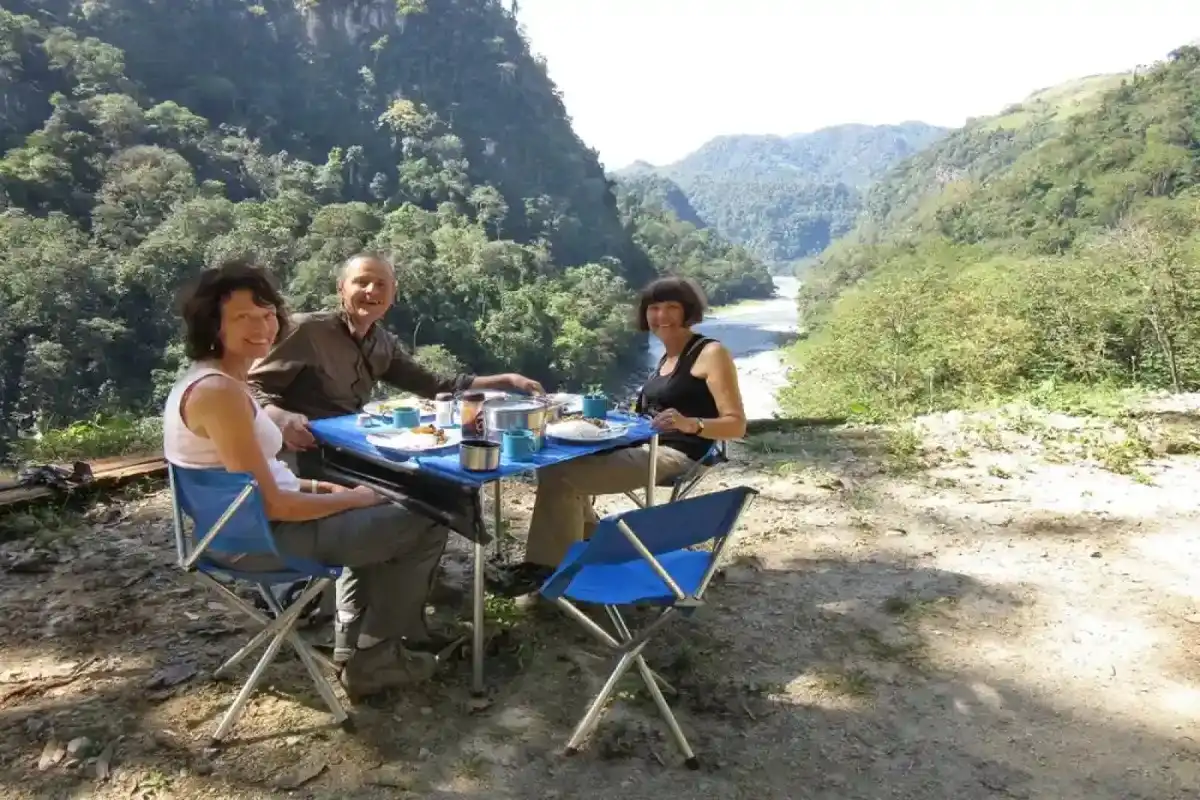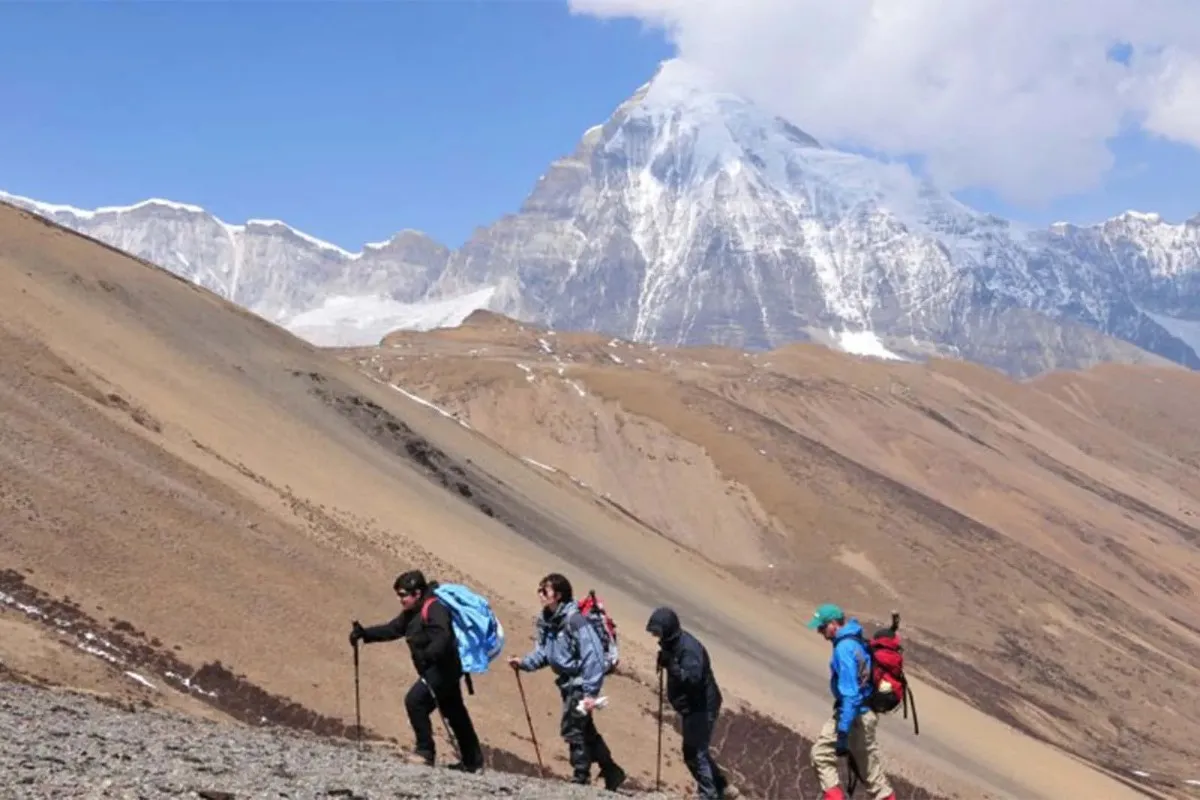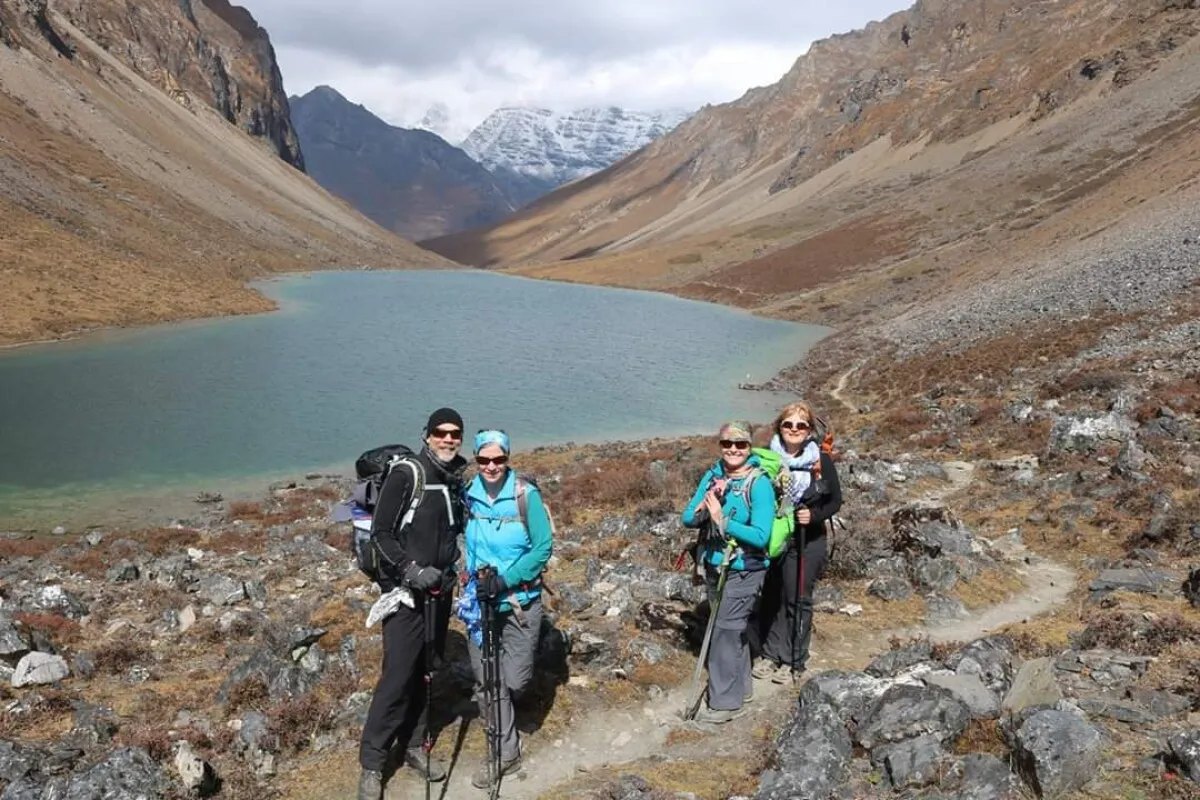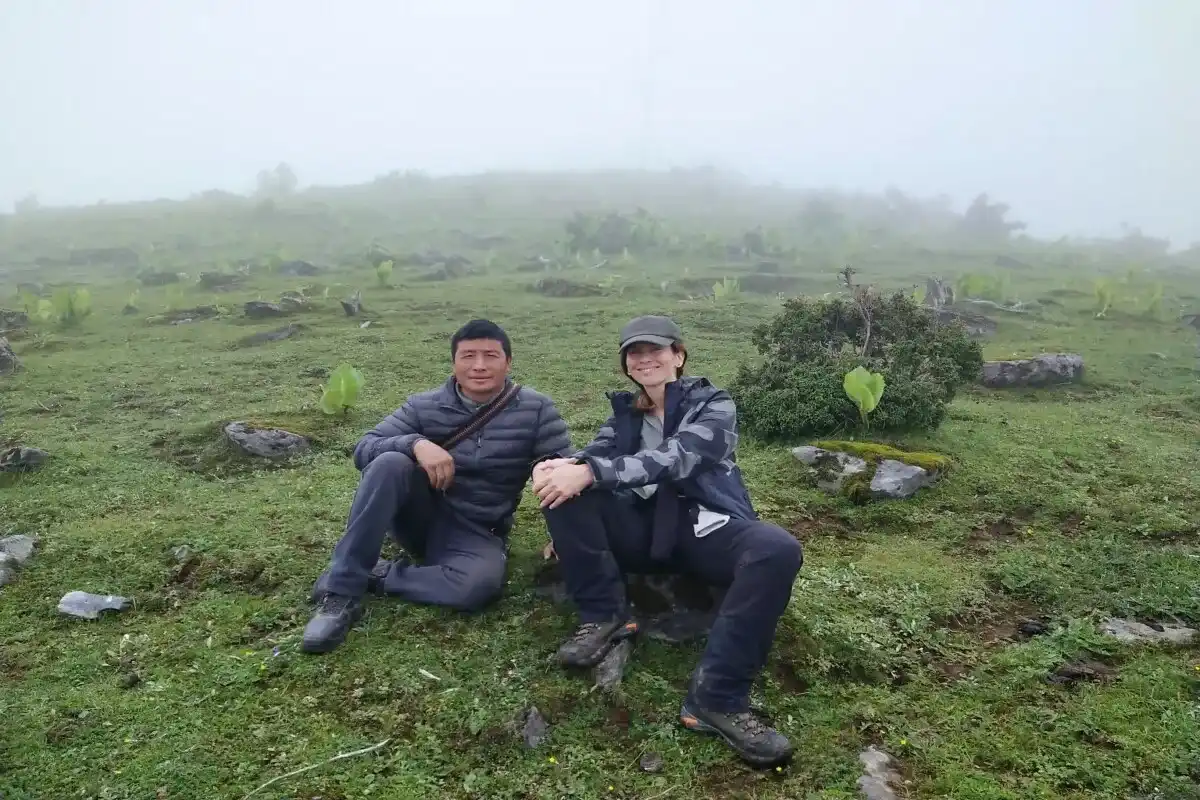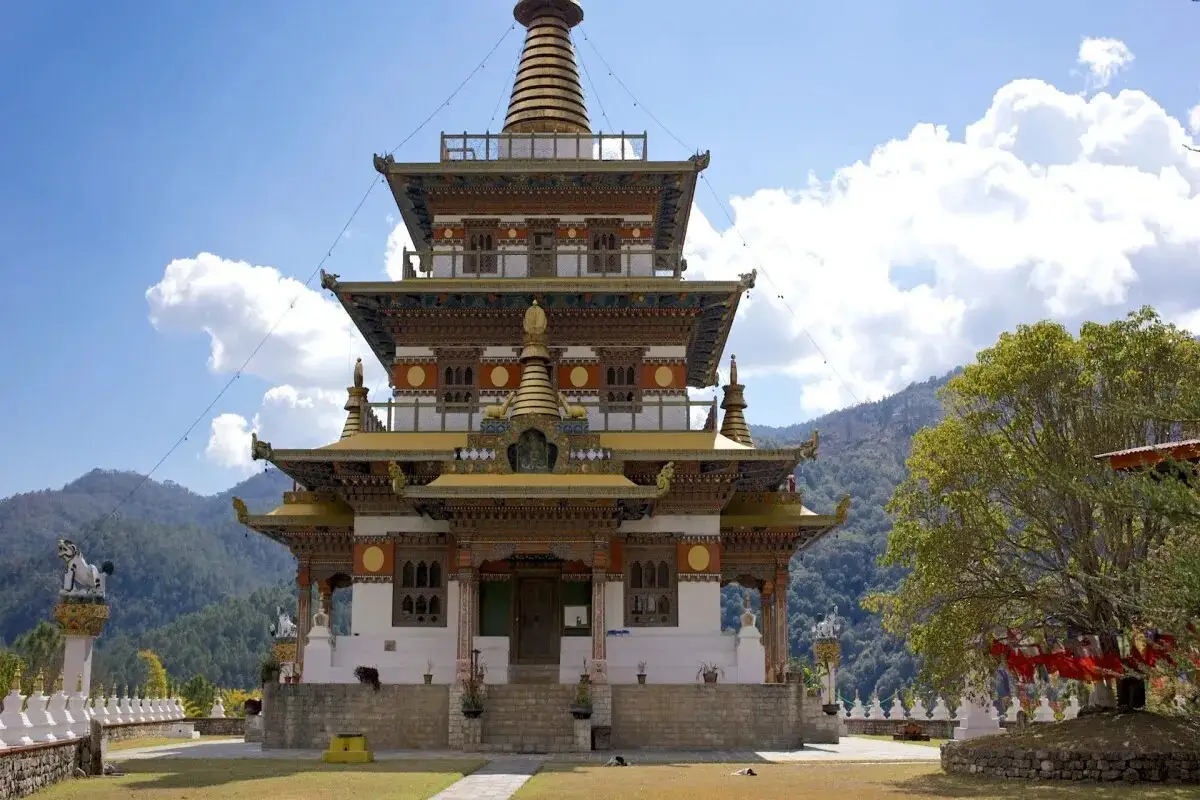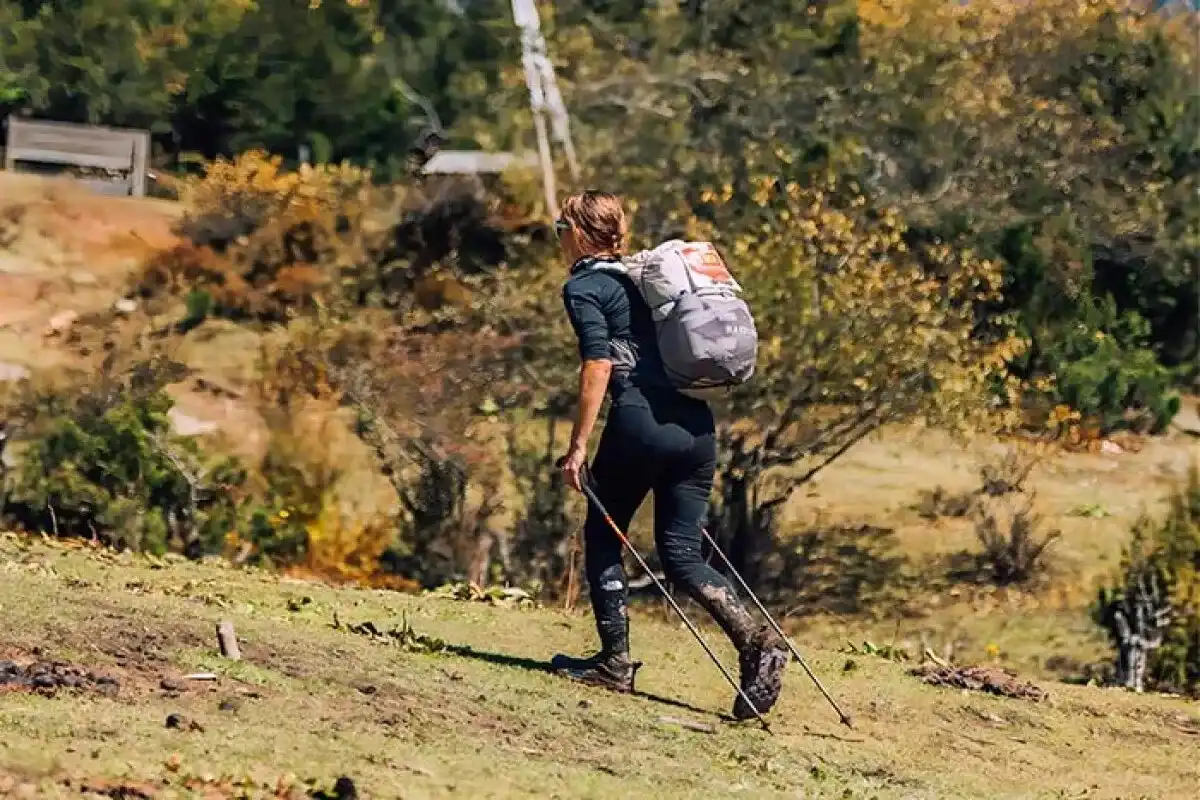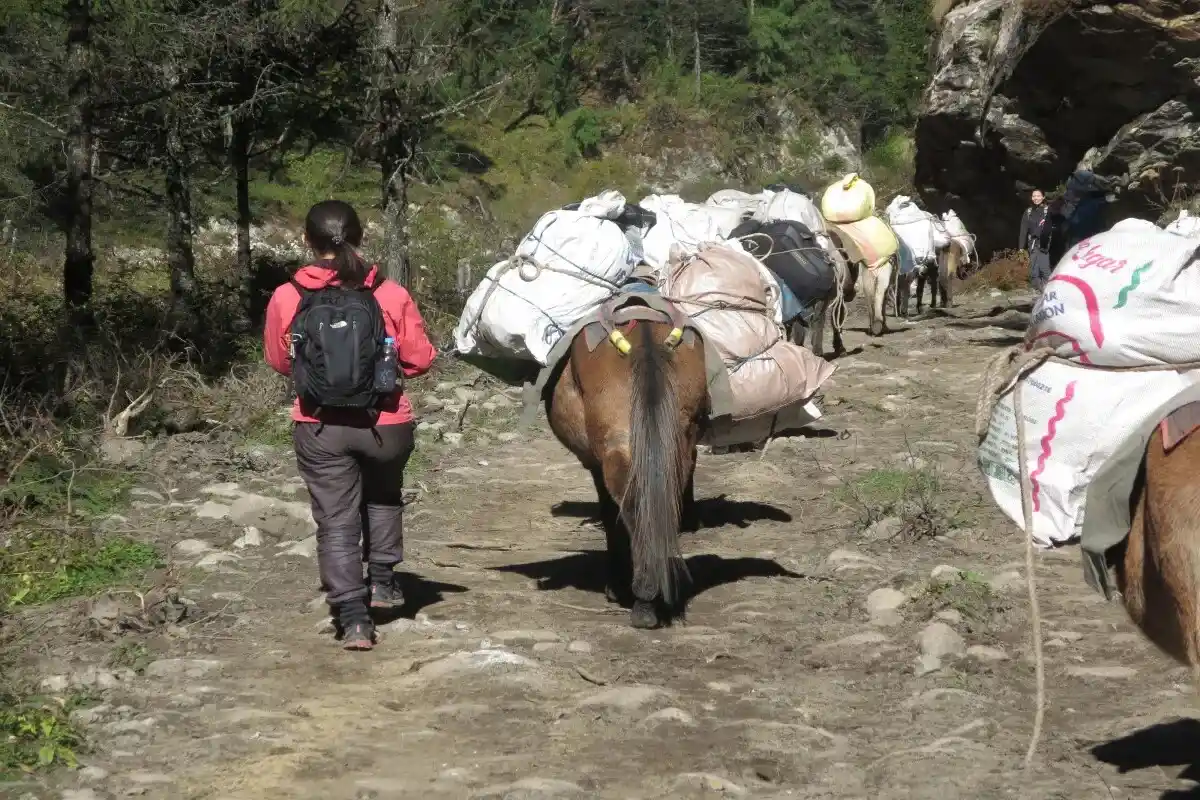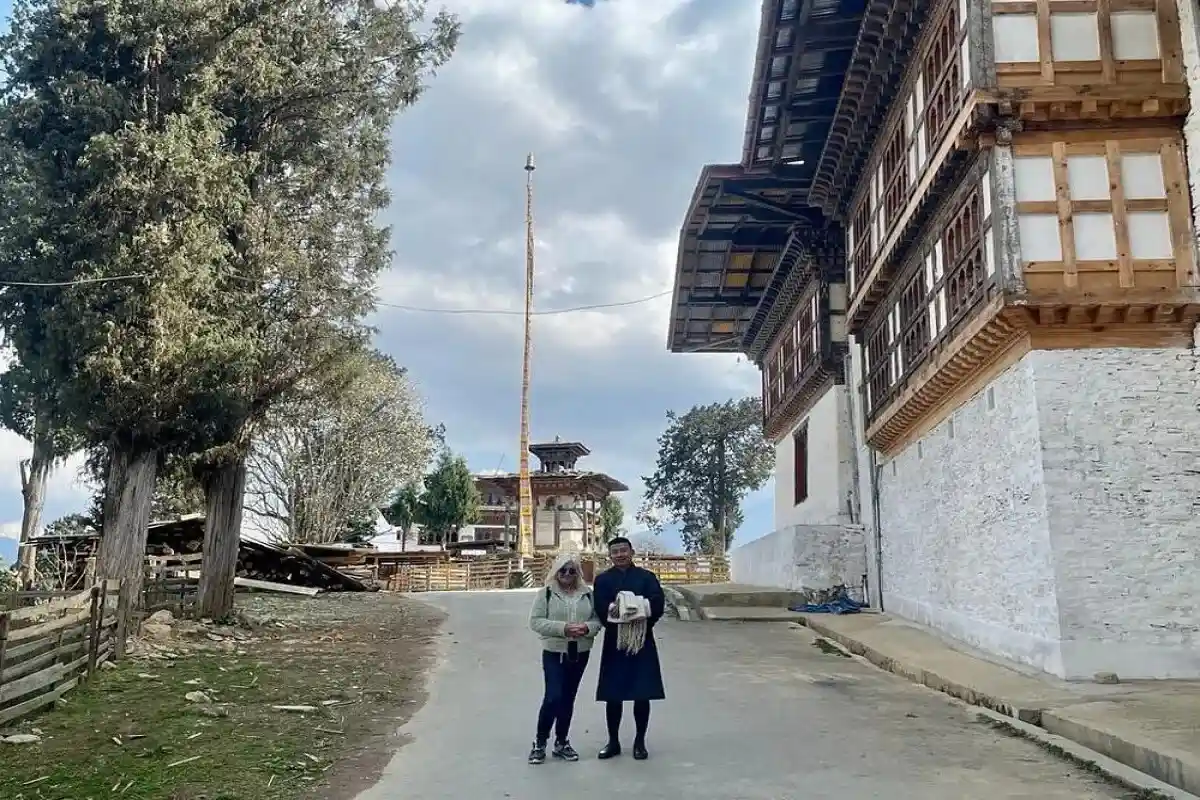Bumdrak Trek - 6 Days
Think how enjoyable it would be when walking through forests, watching old temples, and admiring huge sculptures of Buddha. To fulfill all this enjoyment, we have planned a 6-day Bumdrak trek. The Bumdrak 6-day journey lets you learn about Bhutan's past, explore its beautiful landscapes, and enjoy its culture and religion.
Highlights
- Sightseeing in Paro and Thimphu Valley
- Trek to the sacred Bumdra Monastery.
- Exploring Thimphu and the surrounding areas
- Experiencing the awe of Tiger’s Nest Monastery
Trip Overview
Your journey will start at the airport in Paro. After that, you'll go to Thimphu. You will see forests, mountain peaks, and the famous Tiger's Nest Monastery. You will also see prayer flags waving, monks chanting at monasteries, and views of snowy mountains along the road. Every day brings something fresh.
You are an adventure lover and want to know about history, then this trek is for you. Since the trek is easy, anyone can participate and enjoy the great times ahead. Orrog gives you a clear plan for the journey. You may plan this vacation according to the time, money, and fitness you have. Call us to find out more about the trip and book a package.
Sightseeing in Paro and Thimphu Valley
A valley sightseeing tour provides spiritual, natural, and cultural explorations. One of the locations you should not overlook is Paro Dzong, where you get to glimpse a great fort. You can also visit several monasteries and ancient temples. You can purchase goods that have been locally produced at the weekend market. You can then move on to visit the suspension bridge and the museum. Autumn and spring are the ideal seasons to visit these locations.
Exploring Thimphu and the surrounding areas
The capital of Bhutan is Thimphu. The valley combines old culture with technological advances. The valley is situated at the riverbank. You can see a big statue of Buddha at Buddha Dordenma. You can then visit the Chorten and the fort. Punakha and Dochula Pass are nearby destinations.
Undertake the trek to the sacred Bumdra Monastery.
The Bumdra Monastery Trek is an exciting journey. During this expedition, you may observe the Valley's magnificence. This journey is famous to tourists for its views. You will start your trek from Sang Choekor Buddhist College. You can also camp near the monastery. On the way, you will cross many spans and forests.
Experiencing the awe of Tiger’s Nest Monastery
To visit the Monastery, you should start the trek in the morning. This monastery is an important site for Buddhists. This monastery is a legendary and sacred site. You will begin your hike from Takstang. You may observe beautiful scenery and prayer flags along the walk. From the monastery, you will receive a perfect view.
Best Seasons to visit Bumdrak monastery
You can visit the Bumdrak monastery anytime. It is advisable to go there between late September and May end. During these months, you will find a lot of pilgrims. During these months, you can find flowers in bloom. You will also have an amazing view of different peaks. Locals attend the Wangdue Tshechu and Thimphu Tshechu festivities in September. You can enjoy their festivals and witness their culture.
Conclusion
You will remember more than just the images you took after your trip to Bhutan is over. You will remember the snow-capped mountains, the sound of prayer wheels, and the warm people. This country is filled with activities that are off the beaten track, from the visit to the gold Buddha to the trek to Tiger's Nest. The country will be imprinted in your mind, and you'll yearn to go back. The trip is once in a lifetime in the way that you'll remember it for years. Bhutan will stay with you forever.
Your journey will start at the airport in Paro. After that, you'll go to Thimphu. You will see forests, mountain peaks, and the famous Tiger's Nest Monastery. You will also see prayer flags waving, monks chanting at monasteries, and views of snowy mountains along the road. Every day brings something fresh.
You are an adventure lover and want to know about history, then this trek is for you. Since the trek is easy, anyone can participate and enjoy the great times ahead. Orrog gives you a clear plan for the journey. You may plan this vacation according to the time, money, and fitness you have. Call us to find out more about the trip and book a package.
Sightseeing in Paro and Thimphu Valley
A valley sightseeing tour provides spiritual, natural, and cultural explorations. One of the locations you should not overlook is Paro Dzong, where you get to glimpse a great fort. You can also visit several monasteries and ancient temples. You can purchase goods that have been locally produced at the weekend market. You can then move on to visit the suspension bridge and the museum. Autumn and spring are the ideal seasons to visit these locations.
Exploring Thimphu and the surrounding areas
The capital of Bhutan is Thimphu. The valley combines old culture with technological advances. The valley is situated at the riverbank. You can see a big statue of Buddha at Buddha Dordenma. You can then visit the Chorten and the fort. Punakha and Dochula Pass are nearby destinations.
Undertake the trek to the sacred Bumdra Monastery.
The Bumdra Monastery Trek is an exciting journey. During this expedition, you may observe the Valley's magnificence. This journey is famous to tourists for its views. You will start your trek from Sang Choekor Buddhist College. You can also camp near the monastery. On the way, you will cross many spans and forests.
Experiencing the awe of Tiger’s Nest Monastery
To visit the Monastery, you should start the trek in the morning. This monastery is an important site for Buddhists. This monastery is a legendary and sacred site. You will begin your hike from Takstang. You may observe beautiful scenery and prayer flags along the walk. From the monastery, you will receive a perfect view.
Best Seasons to visit Bumdrak monastery
You can visit the Bumdrak monastery anytime. It is advisable to go there between late September and May end. During these months, you will find a lot of pilgrims. During these months, you can find flowers in bloom. You will also have an amazing view of different peaks. Locals attend the Wangdue Tshechu and Thimphu Tshechu festivities in September. You can enjoy their festivals and witness their culture.
Conclusion
You will remember more than just the images you took after your trip to Bhutan is over. You will remember the snow-capped mountains, the sound of prayer wheels, and the warm people. This country is filled with activities that are off the beaten track, from the visit to the gold Buddha to the trek to Tiger's Nest. The country will be imprinted in your mind, and you'll yearn to go back. The trip is once in a lifetime in the way that you'll remember it for years. Bhutan will stay with you forever.
Short Itinerary
Arrive at Paro, drive to Thimphu, visit Tashichho Dzong, and rest.
Hike to Dodedra Shedra, visit Buddha Dordenma, Memorial Chorten, and Thimphu market.
Hike Lungchutse to Dochu-la Pass, visit Druk Wangyel Lhakhang, the museum, and Paro Dzong.
Trek from Paro to Bumdrak via Chechemhen and explore Bumdrak Temple.
Hike to Tiger’s Nest via monasteries, visit Drukgyel Dzong & Kiychu Lhakhang, farewell dinner.
Final breakfast and airport drop with farewell views of Bhutan.
Price Includes
- Pick-up and drop-off services
We provide a pick-up service from the airport to the hotel on your arrival day and from the hotel to the airport on the departure day.
- Lunch, Breakfast, and Dinner
All meals during the trek will be provided by the company. However, personal food items like coffee, tea, cold drinks, etc, are not included in the package.
- A guide proficient in English
A certified, English-speaking guide will accompany you throughout the trip. The guide will offer information about the trail, culture, nature, and history, and ensure your safety and a smooth experience.
- Comfortable SUV vehicle
A private SUV will be used for road travel before or after the trek. These vehicles are ideal for Bhutan’s hilly terrain and provide a comfortable ride.
- All types of entry costs
This covers all permit fees, monument entrance fees, park fees, and any other official charges required for trekking or sightseeing activities during the tour.
- Professional Drive
We ensure a safe and smooth drive during your tour. We have licensed and experienced drivers for that.
- Sleeping bag and tent
Quality sleeping bags and tents are provided for your comfort and warmth during the camping nights on the trek. So, you don’t have to worry about buying a new one.
- Farewell dinner
A special farewell meal, typically arranged in a traditional restaurant, is offered at the end of the tour to celebrate the journey and thank the participants.
- Evening Tea/coffee with snacks
Each evening, you’ll be served tea or coffee along with light snacks like biscuits and popcorn.
- Drinking Water
Safe and clean drinking water is provided throughout the trek
- Pick-up and drop-off services
We provide a pick-up service from the airport to the hotel on your arrival day and from the hotel to the airport on the departure day.
- Lunch, Breakfast, and Dinner
All meals during the trek will be provided by the company. However, personal food items like coffee, tea, cold drinks, etc, are not included in the package.
- A guide proficient in English
A certified, English-speaking guide will accompany you throughout the trip. The guide will offer information about the trail, culture, nature, and history, and ensure your safety and a smooth experience.
- Comfortable SUV vehicle
A private SUV will be used for road travel before or after the trek. These vehicles are ideal for Bhutan’s hilly terrain and provide a comfortable ride.
- All types of entry costs
This covers all permit fees, monument entrance fees, park fees, and any other official charges required for trekking or sightseeing activities during the tour.
- Professional Drive
We ensure a safe and smooth drive during your tour. We have licensed and experienced drivers for that.
- Sleeping bag and tent
Quality sleeping bags and tents are provided for your comfort and warmth during the camping nights on the trek. So, you don’t have to worry about buying a new one.
- Farewell dinner
A special farewell meal, typically arranged in a traditional restaurant, is offered at the end of the tour to celebrate the journey and thank the participants.
- Evening Tea/coffee with snacks
Each evening, you’ll be served tea or coffee along with light snacks like biscuits and popcorn.
- Drinking Water
Safe and clean drinking water is provided throughout the trek
Price Excludes
- International Airfare
- Visa Charges and Insurance
- Individual expenditures
- Additional-day lodging
- Laundry and telephone expenses
- Tips for the guide and the porter
- International Airfare
- Visa Charges and Insurance
- Individual expenditures
- Additional-day lodging
- Laundry and telephone expenses
- Tips for the guide and the porter
Bumdrak Trek Itinerary
Today, you will land at Paro International Airport. An Orrog representative will be waiting for you at the airport. You will receive assistance from a representative during the check-in process. After that, a private vehicle will drop you to Thimphu. You will see a stunning view of Bhutan while you are travelling.
After arriving in Thimphu, you will register at a hotel. You can unwind and refresh upon reaching the hotel. Then, you will visit Tashichho Dzong. Upon exploring the monastery, you will return to the accommodation. You will be spending the night at Thimphu.
You need to get up early today. Then, you will start your trek toward the Dodedra Shedra. You will begin your hike from Dechencholing. To reach Dechencholing, we will drop you off in a private car. You have to hike uphill until you get to the Dodedra Shedra. After a small hike, you will reach Dodedra. Once you reach Dodedra, you will visit the temple. Thereafter, you will explore the small museum. Here, you can learn about the history. In this peaceful spot, you can relax and capture moments. You will go to Thimphu after exploring the temple. After reaching Thimphu, you will have your lunch.
You will visit the Buddha statue in the afternoon. A gigantic golden statue of Buddha is present here. Then, you will visit a memorial chorten. You can see spinning wheels and colorful prayer flags here. From the chorten, you will descend to Norzin Lam.
In the evening, you’ll visit the handicraft market. There, you can find many Bhutanese souvenirs. You can explore the market yourself and discover more of Thimphu. You'll be staying at the same place tonight.
You will begin your day with a short ride and travel up to Hongtsho. From this village, you will travel to Tashigang. From this gompa, your hike will begin. You will hike in the beautiful forest. In the forest, you can see a variety of trees and birds. You will arrive at Lungchutse Gompa after hiking for a few hours. You can take in 360-degree views of the mountains from here.
After spending some time in the monastery, you will descend to Dochu-la Pass. You will arrive at Dochu-la Pass after several hours of descent. You will have an excellent view of the surroundings once you arrive at the pass. You can enjoy the outdoors here. Subsequently, you will proceed to the Druk Wangyel Lhakhang. You will find beautiful wall paintings and tales of Bhutan's fourth king here.
You will go to Paro later in the afternoon. Upon arrival in Paro, you will explore the Museum. The history and culture of the country are narrated here. Lastly, you will visit Paro Dzong. Overnight, you will stay at Paro.
Today, you need to get up early. After that, you will ride to the Sang Choekor Buddhist College. You will begin your trek from here. The trek begins with a steep climb through a serene forest. You will stop for lunch at Chechemhen after several hours of walking. This vantage point offers a clear view of the Paro Valley. You will begin your trek again after lunch and a couple of hours of rest.
The trail gets easier from Chechemhen. You must ascend until you arrive at camp. Once you reach camp, you will see a Bumdrak Temple. You will explore the temple. If you are not too exhausted, and you'd like to see more, then you can hike to a vantage point. From this vantage point, Jomolhari Peak can be seen.
After exploring the temple. You will stay in a tent. From your tent, you can watch colorful Himalayan monals. This day will be peaceful and special, filled with nature, views, and spiritual sites.
Today is your final day of trek. You will begin your trek after enjoying breakfast at camp. You will descend on the same path. You will begin your trek through a quiet, thick forest. After descending for an hour, you will arrive at Oselgang Monastery. Here, you will see the trees open up. The Paro Valley can be seen from this monastery.
You will arrive at Ogyen Tsemo Temple after a short descent from a monastery. You will descend into a narrow valley from here. After that, you can ascend to Zangto Pelri Lhakhang. A beautiful temple situated atop a cliff can be found here. This location provides a view of the monastery's rooftops. You must descend from this location to reach the monastery. Upon arrival, you may explore the monastery and enjoy a tranquil ambiance.
Upon appreciating the tranquility and aesthetic appeal of the monastery, you will proceed to the parking area. Our car will be waiting there. You'll then get on a vehicle. During the expedition, you will observe Drukgyel Dzong and Kiychu Lhakhang. We will transport you to the hotel following your visit to these places. You can relax and take a shower once you arrive at the hotel. We will plan a farewell dinner for your group in the evening. You will stay at Paro today.
Today is the last day of your trip through Bhutan. You will savor your final meal in Bhutan after waking up. You will then pack your bags. If you want something at the last minute, we will help. We will drive you to the airport. Before we head to the airport, take a look around again. You can see happy faces, hills, and serene roads outside the window. At the airport, your guide will help you with the check-in process. They will ensure that everything goes without a problem. Your guide, who has accompanied you during your journey, will be leaving you. Take a last look at Bhutan through the window as your flight takes off. Many of your memories of this unique location will stay with you.
Know Before You Travel
-
Bumdrak trek is a moderate trek:
Anyone can do this trek. You need a good level of stamina to complete this trek. The trail consists of forest paths, ridges, and rocks. You need to do daily exercise for 2 to 3 months before the trek.
-
Weather conditions:
Bumdrak is around 3,800 meters high and has a Himalayan high-altitude environment. You'll stay cool all the time. In summer and winter, you get sunny days. The spring and autumn seasons are the best to participate in this trek. It is raining in the spring, and it is snowing in the winter. So get ready for both.
Bumdrak Map
Download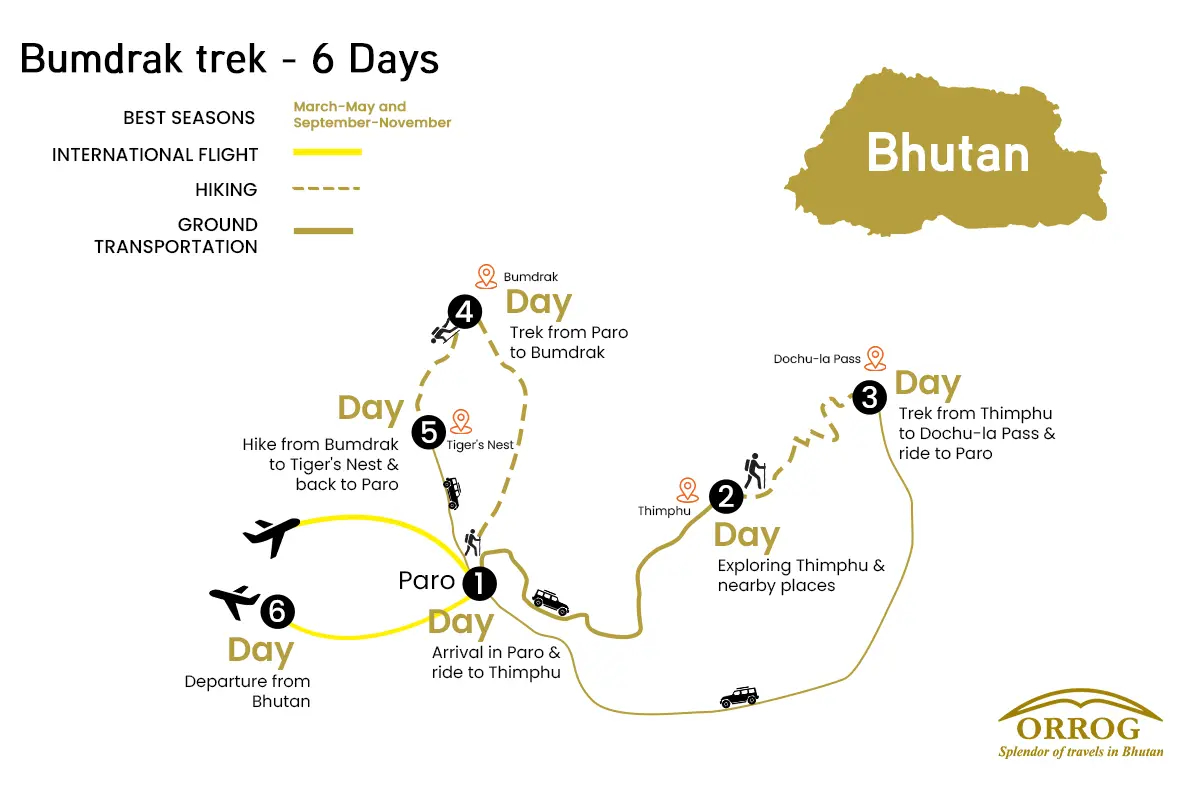
Bumdrak Trek Video
FAQs for Bumdrak Trek
Orrog is a certified travel company and has years of experience with a certified guide.
Yes, all age groups can join this trek. But you should be aware of altitude sickness and be physically ready for a walk.
Yes, you can combine the trek with other tours. We will arrange your tour according to your chosen location.
Yes, trekking to the mountain is completely safe with us. But there is only the risk of acute mountain sickness.
The highest altitude you will reach in the Bumdrak trek is 4,000 m.
Bumdrak trek is completely safe. If you suffer from any problem, you can seek help from locals.
You should walk at a steady pace and avoid all types of liquids. Keep the altitude sickness medication "Diamox."
The best times for this trek are spring, from March to May, and autumn, from September to November.
On average, you must walk for 4 to 5 hours every day.
The weight limit is not applicable. Your ability to walk and carry a big bag depends on you.
Yes, if you are physically fit, this journey is appropriate for beginners.
Yes, you can see different mountains in the Bumdrak Trek.
Bumdrak Trek is located in Paro District in the western part of Bhutan.
Yes, you will easily get electricity on this trek.
Bhutan uses types C, D, and G plugs. Voltage is 230V, 50Hz
Yes, it's advisable to bring a universal travel adapter.
Charging opportunities are limited, mostly available at the beginning and end of the trek.
Power supply is generally stable, but occasional outages can occur.
It's not recommended during the trek due to limited power availability.
You need a visa and all necessary permits for your trip. These documents can not be received on the day of your arrival, so they must be processed before coming here. After you book a trip with us, we will manage these papers for you. Your Bhutan visa is arranged by Orrog as part of the package.
The main way to come to Bhutan is through Paro International Airport, which is well-connected to cities like Bangkok, Delhi, Kathmandu, and Singapore. Most people arrive by air, but if you plan to come via road, you can enter through Phuentsholing, located on the southern border with India, which is the most commonly used entry point.
It is recommended to apply for the visa at least 20 days before your planned departure date so that there is enough time for processing your Bhutan visa, finalizing your itinerary, and arranging your guides and transportation. Although visa processing itself is relatively fast once payment is received, early preparation helps avoid delays and ensures availability, especially during peak seasons (spring and autumn).
You don’t require a passport-size photo for the visa, but it is wise to carry at least 2–4 recent passport-sized photographs during your trip. These may be needed for local permits, registration, or when applying for a local SIM card upon arrival in Bhutan.
Yes, you can lengthen your stay in Bhutan either before or after your trip. Bhutan’s tourism model requires visitors to pay a Sustainable Development Fee (SDF) and a daily package cost, so any extra days will involve additional charges. Extensions are a great opportunity to explore cultural sites in Paro, Thimphu, or even add another short trip or day hike.
Yes, Bhutan requires full tour payment in advance before your visa can be processed and issued. The government of Bhutan regulates this policy to ensure that all travel arrangements are confirmed through a licensed Bhutanese tour operator. We are a licensed tour operator that ensures you have everything you need for a trouble-free trip.
Orrog offers packages with the customer in mind that guarantee a hassle-free travel experience.
Any personal expenses are not covered in the package like:
- Tips for your guide and other staff
- Bottled drinks and snacks(personal expense)
- Souvenirs or local crafts
Credit cards are easily accepted in major cities like Paro and Thimphu. But in remote areas, you may not have access to a card or an ATM. So, it is best to carry some cash before heading for the trip.
Tipping is not mandatory, but it is a widely appreciated gesture and a customary way to show gratitude for good service. The tipping guideline would be to give USD 5-10 per day as a tip for the guides and other staff.
Paro International Airport is the only international airport in Bhutan. It is well connected by flights from cities like Bangkok, Delhi, Kathmandu, and Singapore.
yes, airport pick-up and drop-off are included in the package. We will have your guide and driver meet you at the airport and transport you to your hotel.
While Bhutan's roads are mostly paved, some parts are narrow, winding, and occasionally affected by weather. However, we ensure your travel is safe, well-maintained, and driven by an experienced professional throughout the journey.
The Bhutanese Ngultrum is used in Bhutan. All local transactions during the trip will be in BTN.
US Dollars (USD) are generally accepted at larger hotels, souvenir shops, and tour operators, particularly in Paro and Thimphu. However, it’s advisable to convert your currency to BTN for general purchases in rural areas. Other currencies like the Euro or the Pound are not commonly accepted directly.
No, credit or debit cards are not accepted on the trip, as it takes you through remote regions with no banking or electronic payment access. All trip-related payments like accommodation, meals, permits, etc, are paid in advance.
You can exchange foreign currency at the Paro International Airport, at banks, or through licensed money changers in cities like Thimphu and Paro. It's best to exchange enough cash before heading out on the trip.
The national language is Dzongkha, but many Bhutanese also speak English. If you speak English and are worried about communicating with the local people, you will have your guide as a translator.
Yes, all licensed tour guides in Bhutan are required to speak fluent English. Many are also trained in other languages such as German, Japanese, or French. Communication during the trip will be smooth and clear in English.
Most signboards, tourist maps, and information brochures are written in English, especially in tourist destinations like Paro, Thimphu, and trailheads. Directional signs along routes are often labeled in both Dzongkha and English.
No, learning Dzongkha is not at all needed for the trip, but knowing a few basic words like "Kuzu zangpo la" (Hello) or "Kadrinche la" (Thank you) is a good way to interact with the locals
Language barriers are minimal, as your guide will handle all communication with locals and support staff. Your guide will translate for you during your interaction with the locals.
To greet people, you can greet with locals “Kuzu zangpo la” (Hello) by performing a slight bow. Most common greetings include physical greetings, such as shaking hands less visible, especially in rural areas.
Yes, but remember to seek permission, especially when taking photos of monks, locals, or temples. Please note that clicking photos is not allowed at most religious sites.
Visitors should dress modestly and respectfully. This means:
- Covering shoulders and knees
- Removing hats and sunglasses
- Not wearing shorts or sleeveless tops
This applies to both men and women.
Yes, Bhutanese society is deeply rooted in Buddhism and tradition. Here are some key taboos:
- Do not point your feet at people or sacred objects
- Never touch anyone on the head, as it is considered sacred
- Walk clockwise around temples, stupas, and religious monuments
- Avoid public displays of affection
While gifts are not expected, they may be accepted graciously if given with respect. It is advisable to consult with the guide before giving out anything.
Bhutan follows Bhutan Time (BTT), which is UTC/GMT +6 hours. This time zone remains consistent throughout the year.
No, Bhutan does not observe daylight saving time. The country maintains the same time year-round.
Bhutan is 30 minutes ahead of India. For example, 12:00 PM in India is 12:30 PM in Bhutan.
Yes, souvenirs can be bought in Paro or Thimphu before or after the trip.
Some popular souvenirs include hand-woven textiles (kira and gho fabric), prayer flags, thangka (religious scroll) paintings, handmade paper products, traditional masks, and Buddhist artifacts.
You can do some gentle bargaining in local street markets. However, in government-run shops and fixed-price stores, prices are usually non-negotiable.
Yes, you can easily purchase a SIM card upon arrival in Bhutan. We will assist you with the process, and you'll need a passport copy and a passport-sized photo.
No, internet access is not available during the trip. However, Wi-Fi is available in hotels in Paro and Thimphu before and after the trip.
Yes, it is highly recommended to inform friends and family before the trip that you will be offline for several days, so they are not concerned by the lack of communication.
B-Mobile (by Bhutan Telecom) and TashiCell are the two main service providers. B-Mobile tends to have better coverage in rural and mountainous areas
Yes, snow is quite likely, especially at higher elevations, which are above 4,800 meters. If you trek during late autumn (October–November) or early spring (March–April), you may encounter snowfall. During the peak of spring (April–May) and autumn (September–early October), trails are usually clear, although sudden weather changes in the mountains can still bring unexpected snow showers. You should always be prepared for cold conditions and potential snowfall, regardless of the season.
No, Treks are not accessible throughout the year. The trail is generally closed during the winter(December- February) due to heavy snowfall that makes high mountain passes impassable and increases the risk of avalanches and extreme cold.
Since the weather can be unpredictable and temperatures can vary drastically, layered clothing is essential. You should pack:
- Base layers (thermal tops and bottoms)
- Insulating layers like fleece or down jackets
- Waterproof and windproof outer layers
- Warm hats, gloves, and neck gaiters for freezing conditions
- Moisture-wicking socks and weatherproof trekking boots
The weather is clear with mild daytime temperatures during spring and autumn. But you will be travelling in high altitudes, so it is necessary to carry enough clothing because you will encounter lower temperatures. The nights are freezing cold at high altitudes. So, pack accordingly.
This Trek is classified as moderate to strenuous, basically due to its location, the long trail, and several days of camping. The track, although not tough, is more suited to people who have earlier hiking or trekking experience. Beginners with good fitness and determination can still complete the trek, but we recommend undertaking some pre-trip training, such as having a long walk or doing some cardio exercises.
This trip is mainly for people aged between 12 and 65. But if you are physically fit and have the willpower to complete this trek, you can complete this trek because we will be there to help you in case of any problem.
A Medical certificate is not mandatory, but a health check-up is advised. Since the trek reaches altitudes over 4,800 meters (15,750 feet), you can have a normal checkup before the trek to make sure that you have no ongoing issues.
Yes, your children can join the trek if they are in good physical condition, which requires walking for a few hours every day. They should have parental guidance during the trek.
Yes, senior citizens can participate, given that they are fit to complete this trek. A visit to the Doctor is strongly advised, and seniors should engage in pre-trek training to improve stamina and cardiovascular health.
During this Trek, you will stay in tented camps at remote, scenic campsites along the trail. These camps are fully supported and managed by us. Before and after the trek, you will stay in comfortable hotels or guesthouses in Paro and Thimphu. All accommodations are arranged by us as part of your package.
Yes, all campsites are carefully chosen, keeping safety, cleanliness, and hygiene in mind. Orrog follows strict sanitation practices, including setting up toilet tents, safe waste disposal, and clean food preparation areas. You’ll also be accompanied by well-trained staff to ensure your safety during the trip
Yes, all campsites are carefully chosen, keeping safety, cleanliness, and hygiene in mind. Orrog follows strict sanitation practices, including setting up toilet tents, safe waste disposal, and clean food preparation areas. You’ll also be accompanied by well-trained staff to ensure your safety during the trip.
Yes, hot water for drinking is available at camps, but not hot water for showers. You can carry biodegradable wet wipes for convenience.
Each campsite is equipped with portable toilet tents or simple pit latrines, maintained by the support team to ensure cleanliness and privacy. While they are basic, they are safe, hygienic, and environmentally conscious. It is advisable to carry your toilet paper, hand sanitizer, and eco-friendly toiletries to maintain hygiene during the trek.
If you experience symptoms such as headache, nausea, dizziness, or fatigue, your guide will have you rest, hydrate, and monitor your condition closely. If symptoms worsen, you will be taken to a lower altitude immediately, which is the most effective treatment. All treks are designed with gradual altitude gain and acclimatization days to minimize the risk.
Yes, emergency helicopter evacuation is available in Bhutan and can be arranged in serious cases such as severe altitude sickness or injury. However, helicopter rescue is costly and not included in standard trek packages, so having travel insurance that covers emergency evacuation is mandatory. Guides and tour operators are trained to handle emergencies efficiently and will contact authorities for evacuation if needed.
This trek is moderate to tough with 6–8 hours of walking per day across rugged terrain and steep trails. The altitude, length, and remote conditions require good physical fitness and preparation.
Yes, emergency helicopter evacuation is available in Bhutan and can be arranged in serious cases such as severe altitude sickness or injury. However, helicopter rescue is costly and not included in standard trek packages, so having travel insurance that covers emergency evacuation is mandatory. Guides and tour operators are trained to handle emergencies efficiently and will contact authorities for evacuation if needed.
Yes, travel insurance is mandatory for all international travelers visiting Bhutan, especially for those trekking at high altitudes. Your insurance must cover:
- Emergency medical treatment
- High-altitude trekking (above 4,000 meters)
- Helicopter evacuation and return to the home country
- Trip cancellation or delay
Yes, travel insurance is mandatory for this trek. Your policy must include coverage for high-altitude trekking (above 4,000 meters), medical emergencies, and helicopter evacuation, as these services can be very costly in remote Bhutanese terrain. Proof of insurance may be required by your tour operator before confirming the trek.
Mobile network coverage is extremely limited along the Trek. While you may get occasional signal in some lower-altitude areas or villages, most of the trail is out of range, especially near the high passes and campsites. It’s best to inform family and friends that you may be offline for several days.
Charging facilities are not available on the trail since the trek passes through remote and non-electrified areas. It is strongly recommended to bring a high-capacity power bank or a solar charger to power essential devices like phones or cameras during the journey.
Yes, you should bring personal gear such as trekking boots, warm and waterproof clothing, gloves, hats, and a sleeping bag. The other necessary items will be managed by us.
Meals are prepared fresh daily by the trek support team and typically include Bhutanese and Tibetan-style dishes like rice, curries, noodles, soups, vegetables, and occasional meat. Tea, coffee, and snacks are also provided. If you have diet restrictions (vegetarian, vegan, gluten-free, etc.), inform your tour operator in advance so arrangements can be made.
Trekking in Bhutan follows strict environmental protocols, including the “Leave No Trace” principle. All trash is collected and carried out by the support team. Trekkers are expected to avoid littering and carry personal non-biodegradable waste, such as snack wrappers or batteries, back to base.
Yes, safe drinking water is provided each day. You are also encouraged to bring a refillable water bottle and, optionally, water purification tablets or a filtration bottle for additional safety and convenience.
Reviews & Ratings
-
Guarantee -
Thimphu,Bhutan -
975+17160228
Ready to Explore Bhutan?
Start your journey today and discover the magic of Bhutan with our expert guides and carefully crafted tours.
Book This Trip
-
No booking or credit card fees -
Best price guarantee -
Full customize trip
Ask a Question
Feel free to ask us anything about this tour. A travel expert will then get back to you as soon as possible
Ready to Explore Bhutan?
Start your journey today and discover the magic of Bhutan with our expert guides and carefully crafted tours.
